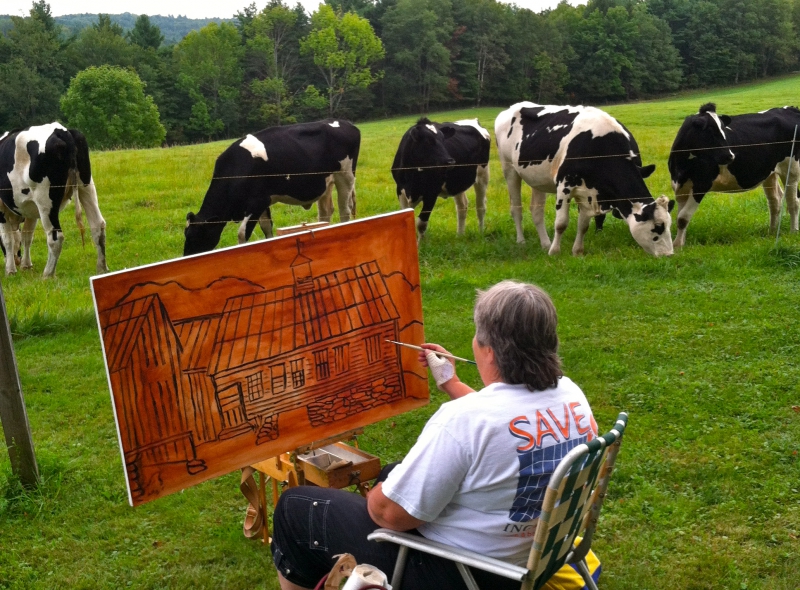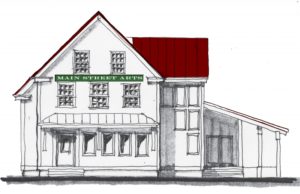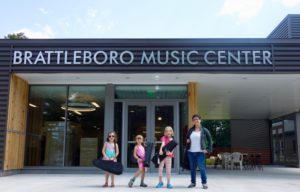By Joyce Marcel
Vermont, once famous for its cows, is now becoming famous for its culture. How big can a rural art economy get? Having taken a big hit in 2008, Southern Vermont’s arts organizations believe they’re riding a creative economy that grows stronger every year.
Over the past 10 years, economic growth has also spiraled upward as many organizations—Brattleboro Music Center and New England Center for Circus Arts in Brattleboro, Weston Theatre in Weston, Next Stage Arts Project in Putney, and Main Street Arts in Saxtons River, for example—expand by building new plants or rehabbing older ones.
Southern Vermont is literally littered with artists. In this small area, consisting of two counties, Windham and Bennington, plus a smidgen of southern Windsor, there are about 300 arts-related businesses that employ nearly 1,200 people according to a 2017 Americans For the Arts survey based on data from Dun & Bradstreet.
That means 178 arts-related businesses employing 411 people in Windham County and 122 arts-related businesses employing 792 people in Bennington.
Not all businesses register with Dun & Bradstreet, so these figures are seriously under-reported, warns Americans for the Arts, which adds, “particularly those that are nonprofit arts organizations and individual artists. The data in this report, therefore, are an undercount.”
A quick snapshot of the region’s artistic health can be found by looking at how the cash flows.
Bennington Museum, for example, has a budget of approximately $900,000. Last year’s operating budget for the Weston Playhouse was $2.2 million; for the 2018 season, they expect to see that rise by “several hundred thousand more,” according to producing director Steve Stettler.
In Brattleboro, the Brattleboro Museum and Arts Center (BMAC) spends close to $600,000 a year. The BMC has a budget that is roughly $630,000 a year. Next Stage in Putney has a budget of about $250,000 a year. Next door, the internationally renowned Sandglass Theater reports earnings of $200,000. The Dorset Theater Festival has an operating budget of $800,000.
The cultural economy supports artists, true, but it also supports gallerists, bookkeepers, accountants, and attorneys. It supports supermarkets, restaurants and shops. It finds its way into the hardware stores, shoe stores, B&Bs, gas stations, propane dealers, carpenters, contractors, health clubs, framing shops, insurance companies, truckers, auto repair shops, caterers and a host of other local businesses.
Bricks and mortar
“About 150 years ago, it was common enough for Vermont communities to construct cultural buildings, funded publicly and privately,” said Zon Eastes, a cellist and conductor who is the former director of outreach and advancement for the Vermont Arts Council. “Many are still in use. Today there is a similar, but different resurgence of cultural construction. It is as exciting as it is indicative of community values and long-term investment.”
Long-term investment indeed. Weston has added a smaller new theater to its current plant; to do that it has already raised $10.8 million of a $13 million capital campaign.
NECCA raised more than $1 million toward its $2 million-plus goal to build its own custom-designed trapezium building in Brattleboro that will allow year-round, indoor flying trapeze training, as well as fabric/silk, juggling, contortion, unicycle, partner acrobatics, German wheel, teeterboard, and more.
The BMC purchased the former Winston Prouty property across from Living Memorial Park in Brattleboro and created a new home that features an education center with studios, office, classroom and recital hall in addition to the adjacent state-of-the-art performance auditorium that seats 225.
The BMC has already raised $5.13 million toward a $5.5 million capital campaign that will allow the organization to fully furnish and equip its new campus, establish endowments to care for instruments and the buildings, and leave the BMC mortgage-free. Prior to the start of the campaign, the organization raised more than $1.3 million to establish a program endowment.
“The last 10 years have seen an economic roller coaster that has made fundraising for BMC’s capital project dramatic,” said violinmaker Douglas C. Cox. “Our community is committed to quality music-making in good time and bad. The hall is an investment that will not only improve the quality of our local music-making and listening, but also in making Brattleboro more of an arts and culture destination. This is a community that loves music and is willing to spend its time and money making, listening to, and supporting exciting local musical projects.”
Brattleboro Museum is also expanding. Two years ago it bought an unused brick building across the Whetstone Brook at 11 Arch St. for $1 from Green Mountain Power. A grant from the Environmental Protection Agency will help clean up some environmental issues; the work will begin soon.
It also has a purchase and sale agreement for a nearby building to give the Arch Street building access to Main Street.
“We’re not leaving our current building,” said BMAC Director Danny Lichtenfeld. “We recently received an amazing gift of over 300 ancient art objects donated to us by a foundation that wants to see them made available for hands-on educational use. Local students, scholars, contemporary artists, and the general public are going to have the opportunity to literally hold these items in their hands. It’s going to be a very special and unusual resource.”
Brattleboro has also added a new, privately owned performance space at 118 Elliot St., where art shows, lectures, concerts and private events fill the room many nights a week.
Vermont Jazz Center is thriving and brings notable musicians to town for concerts every month.
New England Youth Theater (NEYT) has a full production schedule, plus classes in every aspect of the theater arts.
Meanwhile, the town’s sole theater, the Latchis, which also runs a downtown Art Deco hotel, is so busy scheduling film festivals, first-run big-screen Hollywood movies, Bolshoi Ballet, the Metropolitan Opera, and live concerts and events that it bustles almost every day and evening.
In Putney, Next Stage is located in a historic 1841 building and was rehabbed with help from a $370,000 grant from ArtPlace America. It is now totally accessible (with an elevator) and a flexible 200-seat auditorium and an art gallery. There’s even a rehabbed kitchen that makes cooking classes possible.
“We encompass all forms,” said Executive Director Maria Basescu. “We’re trying to break out of the isolation technology can bring and share experiences. This is powerful for a community. We’ve seen arts organizations flame up and die and we feel a great sense of obligation to not squander the incredible support this community has extended to the organization.”
Coalitions and connections
As well as organizations, hundreds of independent painters, sculptors, craftspeople, jewelers, photographers, potters, and filmmakers are living and working in the gorgeous rolling hills of Southern Vermont.
Often they organize. Open studio tours, for example, are popular. The Putney Craft Tour just completed its 39th year. South Newfane’s Rock River Artists just finished its 25th. Brattleboro West Arts just held its eighth. In addition, pop-up shows before Christmas are becoming common.
This year in Manchester, the Southern Vermont Arts Center offered off site exhibit space, throughout the town. The initiative, dubbed ART Manchester, connected Vermont artists with visitors and residents by converting storefronts into pop-up art galleries. The exhibits provided opportunities for local artists to both display and sell their work.
Expect to see more coalitions. For example, Next Stage produces concerts with the classical music Yellow Barn Music Festival as well as folk/rock concerts with Twilight Music and puppet performances with Sandglass.
Last year six theater companies—Main Street Arts, Weston Playhouse, Vermont Theater Company, Putney’s Apron Theater Company, NEYT and Sandglass—came together for the Great River Theater Festival. They put on 18 shows over four days in multiple locations and plan to do it again in 2018.
“We have made great efforts to reach out and collaborate, both within the institution, and especially throughout the region,” said David Stern, artistic director of Main Street Arts.
Stern noted, “We have worked extensively with NEYT, Sandglass Theater, Next Stage, Vermont Theater Company, and more. We have built an organization called the Four County Theater Collaborative—Sullivan, Cheshire, Windham and Windsor—including 18 companies. With them, we are building multiple initiatives designed to promote growth for all. Such initiatives include a collaborative calendar for show selection, a resource sharing database, and the Great River Theater Festival, an annual showcase designed to bring new audiences from greater distance.”
In Manchester, Hills Alive Southern Vermont is composed of the Dorset Theatre Festival, the Green Mountain Academy for Lifelong Learning, the Marble House Project, Manchester Music Festival, Oldcastle Theatre Company, Southern Vermont Arts Center, Taconic Music and Weston Playhouse. Its website maintains a monthly calendar of events at manchestervermont.com/hills-alive.
“The Hills Alive Southern Vermont Arts Festival in Manchester has seen a lot of energy coalescing around people joining forces in marketing and branding,” said Dina Janis, Dorset Theatre Festival’s executive director. “We’ve made ad purchases together to try and bring everyone’s profile up. There’s a lot of collaboration and a lot of smart people in the arts right now working hard to really re-brand the area.”
Another coalition, Art Country, brings together five arts institutions—Bennington Center for the Arts in Vermont plus Clark Art Institute, Williams College Museum of Art, Williamstown Theatre Festival, and Mass MoCA in Western Massachusetts.
High end art
When it was announced last April, the urban news media jumped all over it. Robert Wolterstorff, the executive director of the Bennington Center for the Arts, says attendance jumped as a result of the coverage—and because the museum, always known for its collection of Grandma Moses paintings, upped its game, borrowed some Grandma Moses masterpieces, and put together a show of 60 of her paintings side by side with works by such Modernists as Fernand Leger, Joseph Cornell, Helen Frankenthaler, and Andy Warhol, and artists such as Edward Hicks and Joseph Pickett.
“It’s only once in a generation that you can see so many of her paintings in one place,” Wolterstorff said. “The intention of Art Country is an economic one. Get people to come up here and spend the night. They book a hotel, eat meals, and the next thing you know, they’re shopping on Main Street. Together we have a critical mass.”
The future
What does the future look like for the arts in Southern Vermont? Well, it’s complicated.
According to Wolterstorff, Vermont is missing the mark by not marketing arts tourism.
“People think Vermont is this ’Olde New England’ place that time forgot, and if you’re living in New York, that’s attractive,” Wolterstorff said. “But Vermont has always been a place where people hang out and do cool things. The progressive strain runs deep. Outside of New York, Bennington was the center of contemporary art in the 1960s. There were a whole group of artists like Helen Frankenthaler around Bennington and not a single work is on display. If I had $10 million, I’d build a wing for it. We would become a pilgrimage site.”
The theaters are looking to attract younger audiences. For example, Weston’s new second stage will allow it to broaden its summer producing season into fall so it can work with schools.
“Younger audiences are more interested in experiential programs and last-minute commitments and convening with others through social media,” said Stettler. “Longtime traditional models of marketing and advertising and even artistic producing are necessarily shifting.”
Dorset Theatre just celebrated its 40th anniversary by adding real star power: Tyne Daly, Tim Daly, and Treat Williams appeared last season.
“We had a real breakthrough year in people discovering us outside the region,” Janis said. “We saw a 65 percent increase in our audience. From my standpoint there’s a deep artistic audience in Vermont. With the support of the governor and the Vermont Arts Council, there’s a lot of energy helping to bring up the profile of the Southern Vermont region as an arts destination. The organizations are already here. We just need to get the message out there.”
Going forward, there seems to be more “capacity-changing philanthropy,” Eastes said, adding, “This uptick in culture under-girding might signal a new normal, which lends increasing strength to the central value of arts and culture.”
There are downsides. The town of Bellows Falls, for example, is struggling because a closed bridge over the Connecticut River has meant a significant drop in tourist visits from New Hampshire, said Pat Fowler, an owner of Village Square Bookstore.
Still, the storefronts are nearly fully occupied, the Bellows Falls Opera House has a full schedule of live performances and films, 10 businesses participate in the Third Friday Arts Walk, a new art gallery, AdHoc Gallery, has just opened, along with a new coffee roasting business in downtown and a new German-style restaurant with beer on tap is in the planning stages, and there are plans to rehab the old Hotel Windham, Fowler said.
As founding director of the Rockingham Arts and Museum Project (RAMP), Robert McBride says he’s thrilled with the role artists and the arts play in contributing to the vitality of the downtown. The Exner Block, at 100 percent occupancy, continues to provide affordable housing with a preference given to artists. Flat Iron Exchange provides venues for artists’ gatherings and performances, films and exhibitions. And 33 Bridge St. provides affordable work/studio space.
Bellows Falls provides a template for how rural communities can integrate the arts in their long-term sustainability strategic planning.
Michael Bruno, owner of Windham Antiques Center, at the old Sam’s department store, is renovating another building downtown, an 1890 four-story Italianate brick structure across the street from his store. It will be a mixed-use building combining offices with residential units. The building next to his antique store, formerly an old J.J. Newberry five and dime, is also undergoing renovation, he said.
The vitality of the arts will only grow, Eastes said.
“Vitality is more appropriately measured in not only economic ways, like impact, like community building, like quality of life,” Eastes said. “I envision a Vermont identity that is richly, fully characterized to include arts, culture, creativity, and innovation—not as a cute, you’re-not-serious sidebar, but as a central element of who we are, maybe even more than cheese or skiing or maple syrup. Vermont is an honest place where people can experience authenticity and directness. The arts advance that proposition in a huge way.”


























































